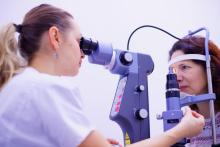Recent Publications

Omry Koren: International consensus statement on microbiome testing in clinical practice (Lancet Gastroenterol Hepatol .)
There is growing interest in the potential exploitation of the gut microbiome as a diagnostic tool in medicine, but evidence supporting its clinical usefulness is scarce. An increasing number of commercial providers offer direct-to-consumer microbiome diagnostic tests without any consensus on their regulation or any proven value in clinical practice, which could result in considerable waste of individual and health-care resources and potential drawbacks in the clinical management of patients. We convened an international multidisciplinary expert panel to standardise best practices of microbiome testing...

Jumanah Essa-Hadad, Michael Edelstein: Enablers to high vaccination uptake among a disadvantaged minority population: a qualitative study of the Arab population of Israel (Isr J Health Policy Res . )
Over 1.9 million Arabs live in Israel and constitute 21% of the total population. Despite being a disadvantaged minority population with wide gaps in health indicators, Arabs have higher Human Papillomavirus (HPV) and Measles, Mumps, and Rubella (MMR) vaccination rates compared with the general Jewish population.

Naama T Cohen: Evaluating Cancer Risk in a Large Cohort of 25,008 Vitiligo Patients: Insights from a Comprehensive Cohort Population-Based Study (J Am Acad Dermatol .)
Current research presents inconsistent results concerning the incidence of various malignancies among patients with vitiligo. Objectives: To evaluate the risk for cancer in patients with vitiligo.

Khalaf Kridin: Meeting Report on "The International Congress on Autoimmune Pre-disease (2024)" (JID Innov . )
The International Congress on Autoimmune Pre-Disease was organized by the German Research Foundation-founded Research Training Group "Autoimmune Pre-Disease" and took place at the University of Lübeck, Germany, on September 16-17, 2024. The event featured various talks and posters from young researchers and international experts and emphasized early interventions and prevention in autoimmune diseases with a focus on systemic rheumatic diseases, pemphigus, and pemphigoid diseases.

Ali Sawaed, Shakad Noah Friedrich, Abed Farhan, Aseel Nassar, Shirin Hamed Azzam: The effect of botulinum neurotoxin A injections on meibomian glands and dry eye (Ocul Surf .)
Assesses the influence of Botulinum neurotoxin A (BoNT-A) injection on meibomian gland function and dry eye in patients diagnosed with Blepharospasm (BPS) and Hemifacial spam (HFS).

Timor Linder, Doron Sudarsky: Left Ventricular and Atrial Function Analysis Following Transcatheter Edge-to-Edge Mitral Valve Repair (J Clin Med . )
Conventional echocardiography used to assess volumes of the left ventricle (LV) and left atrium (LA) along with mitral regurgitation grade is routine in studies before and after transcatheter edge-to-edge mitral valve repair (Mitral TEER). Previous studies focus on LV parameter changes and comparison of the functions before and a few months following Mitral TEER implantation, as well as LA reverse remodeling, by assessing LV volumes. However, less is known regarding LA strain changes in the early phase after the procedure. The objective of the study was to assess the effect of Mitral TEER on LA strain early after TEER procedure.

Nishu Dalal: Exploring micronutrients and microbiome synergy: pioneering new paths in cancer therapy (Front Immunol .)
we outline the importance of micronutrients with an emphasis on the immunomodulatory function of the microbiome and highlight the microbiome's potential as a target for precision medicine in cancer treatment.

Alon Gorenshtein: Mortality and prognosis in herpes simplex Virus-1 encephalitis long-term follow up study (J Neurol Sci . )
Herpes simplex virus-1 (HSV-1) encephalitis is the most prevalent form of viral encephalitis worldwide. Consensus statements on the rate of mortality are lacking, with most studies emphasizing short-term mortality risks . We aimed to describe variables effecting mortality for HSV-1 encephalitis in a long term well defined HSV cohorts.

Michael Edelstein, Haneen Shibli, Jacob Bornstein: Differences in knowledge, attitudes and intentions towards HPV vaccination among young adults from diverse socio-cultural groups in Israel: A cross-sectional study (Vaccine . )
In Israel, The Human Papilloma Virus (HPV) vaccine is recommended to both genders up to age 26. Many 18-26 olds missed their opportunity for vaccination during school. Our study described HPV knowledge, attitudes and vaccination intentions among unvaccinated 18-26 Israeli adults across various demographics, aiming to inform future catch-up vaccination strategies.

Efrat Sharon, Sondra Turjeman, Omry Koren: Fecal microbiome composition in neonates with or without urinary tract infection (Pediatr Nephrol .)
Most infants with febrile urinary tract infection (UTI) do not have an underlying anatomical risk factor. Thus, other non-anatomical risk factors should be considered. Since the most common pathogens arise from the fecal microbiota, our aim was to investigate whether the gut microbiota composition differs between febrile infants younger than 2 months with or without UTI.

Ekaterina Shlush, Talal Sarhan, Rudi Hammudi, Ala Aiob, Alejandro Livoff, Susana Mustafa Mikhail, Lior Lowenstein, Inshirah Sgayer: Placental pathology of IVF-conceived dichorionic diamniotic twins after fresh embryo versus frozen-thawed transfer (Placent
Compares histopathological findings of placentas of dichorionic diamniotic twin pregnancies of in-vitro fertilization (IVF), conceived after fresh embryo transfer (ET) and frozen-thawed ET.

Tomer Bernstine, Sivan Spitzer, Ron Pleban, Ayelet Armon-Omer, Isabelle Kains, Jihad Hamudi, Radi Shahien, Michael Edelstein: Impact of the COVID-19 pandemic on acute cardiology and neurology services in a secondary peripheral hospital (Sci Rep .)
The indirect impact of the COVID-19 pandemic on clinical services in peripheral hospitals has not been fully described. We compared the impact of COVID-19 on Cerebral Vascular Accident (CVA) and ST-elevation myocardial infarction (STEMI) management and outcome in an Israeli peripheral hospital.

Shaked Friedrich: Placenta accreta spectrum: risk factors for unplanned immediate hysterectomy in planned uterine preservation surgery (Am J Perinatol . )
Placenta accreta spectrum (PAS) is a term used to describe trophoblast invasion into the uterine wall. The condition can be fetal at labor due to a lack of spontaneous separation of the placenta from the uterine wall, leading to severe hemorrhage. In this study we aim to evaluate preoperative risk factors for unplanned immediate hysterectomy in PAS uterine-preserving surgeries.

Daniel Soibelman, Ohad Ronen: Completion Thyroidectomy Trends and Rates: A Systematic Review and Meta-Analysis (Clin Otolaryngol . )
In January 2016, the American Thyroid Association (ATA) published an update to the guidelines concerning the management of adult patients with thyroid nodules and well-differentiated thyroid cancers. One of the revised recommendations states that lobectomy is a reasonable surgical approach for low-risk patients. This systematic review compares the rates of completion thyroidectomy surgeries before and after the publication of the recent ATA guidelines.




